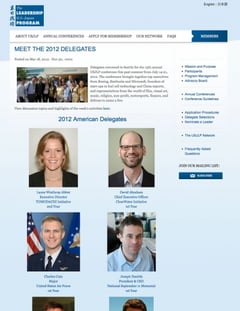Develop an effective association website
 Many associations are exploring digital solutions to improve engagement with their member networks. The challenges of these digitally-minded associations may not be unique. Included in their list of challenges are the ability to drive event engagement, support for association initiatives, better interactions with members and driving value to their network. With the web, associations have the opportunity to reach members in real-time, on-the-go and gain new referrals and advocacy.
Many associations are exploring digital solutions to improve engagement with their member networks. The challenges of these digitally-minded associations may not be unique. Included in their list of challenges are the ability to drive event engagement, support for association initiatives, better interactions with members and driving value to their network. With the web, associations have the opportunity to reach members in real-time, on-the-go and gain new referrals and advocacy.
To develop an effective association website, it is just as important to consider what happens after launch as what is being launched. Sure, the new website must be designed well, be usable and attractive to members and other site visitors. Most organizations, when designing a website, expect the success of the website to hinge on getting it right (with every detail in check) from the beginning. This is rarely the case in reality. Most associations must iterate to make their community, membership website work for their business and member community.
3 planning steps for association websites
- Phase 1: Build the minimum viable product
- Phase 2: Plan for launch (communications, content and feedback)
- Phase 3: iteration and marketing process
Considerations for designing an effective association website
- Use web design iteration to improve the outcome and performance of the association member website. Instead of blowing the entire budget and planning for success within an unrealistic timeframe, plan for developing a high-performance community website in stages--with learning and feedback periods between feature releases. Iterative web design improves the success rate of the project by reducing waste and building relevance for members. Build a minimum-viable project as a first stage, and then build features over time and on a schedule. This process takes more planning, but drives better results for member communities.
- Define the tools or website resources that are valuable to members. Make these tools a priority, and ensure that they are accessible. For example, if members simply want to connect, make it easy for them to find other members and create tools that allow for connections and engagement. You can always drive new value to members in the future, but ensure that they can easily find the tools that they need in the beginning. As members become aware and use newly available tools and resources, then feel free to make adjustments (using an iterative process) over time.
- Awareness of the new website. Many organizations and associations launch their new website with much anticipation, but simply make existing members aware of the new website through an email blast. For one, this is a problem because many organizations only have a 35% open rate on email (or less). Even if the open rate was highly, one email blast does little to express the value of the new website and it's resources. Plan a communication process and engagement strategy that announces the new website (it's design) but also the benefits members will experience as a result of the new website. Encourage members to become advocates for the website using social media, email and other social sharing tools. Also, explain the value of the website through multiple communications, rather than a single eblast. Don't annoy members. Explain how the tool benefits them, and ensure that the new website does in fact benefit them. Build awareness and generate web traffic through events, print collateral, email signatures, email outreach, social media, user groups, Linkedin, homepage announcements, blog posts, Tumblr & Facebook, and possibly even snail mail.
- Build member advocacy. If you work hard to offer tools and resources AND communicate the value of these tools and resources, then you have an opportunity to use member advocacy for your marketing and member growth initiatives. Consider user-generated content, comments, forums or social engagement tools within the association website to drive advocacy. Members may be your greatest marketing tool yet.
- Make it easy to create an account for non-web members. Many members of your association may not have online or website accounts. Perhaps they are confused by the old website and have given up. Consider a re-engagement strategy for these members with the new website. Design the website so it is very clear how to join, who to contact with problems and where to sign-in. Consider using passport logins like the recently expanded Google+ login web developer API, which allows members to login/sign-up with minimal steps.
- Content strategy. Content is often the key to successful communities. Prior to the launch of the new association website, have a plan in place for content creation and approval. Define the areas to receive new content and the publishing schedule.
- SEO strategy. To build visibility of your association, consider a dedicated SEO analysis of your old website during the planning stage, as well as an SEO plan for the new website. Ensure that some part of your content strategy is focused on SEO. Search marketing for member websites can be a powerful way to build membership, advocacy, brand awareness and thereby improve support of your cause or mission.
- Follow design best practices and don't clutter the process. Strong design and clarity of purpose can help improve the success of the new website. Good designers will bring a wealth of best-practices to a website project. Trust and follow their guidance, and prioritize these best-practices rather than designing your website by a committee. Here are a few membership web design best practices can help keep your website on-track, but the most clear takeaway will be to select a designer that has a solid experience base and trust their direction. Guide them from a business perspective--focus less on pixel positions and font styles, and focus more on high-level messaging, value to members and defining business goals and the website's role in helping to achieve them.

 Many associations are exploring digital solutions to improve engagement with their member networks. The challenges of these digitally-minded associations may not be unique. Included in their list of challenges are the ability to drive event engagement, support for association initiatives, better interactions with members and driving value to their network. With the web, associations have the opportunity to reach members in real-time, on-the-go and gain new referrals and advocacy.
Many associations are exploring digital solutions to improve engagement with their member networks. The challenges of these digitally-minded associations may not be unique. Included in their list of challenges are the ability to drive event engagement, support for association initiatives, better interactions with members and driving value to their network. With the web, associations have the opportunity to reach members in real-time, on-the-go and gain new referrals and advocacy.